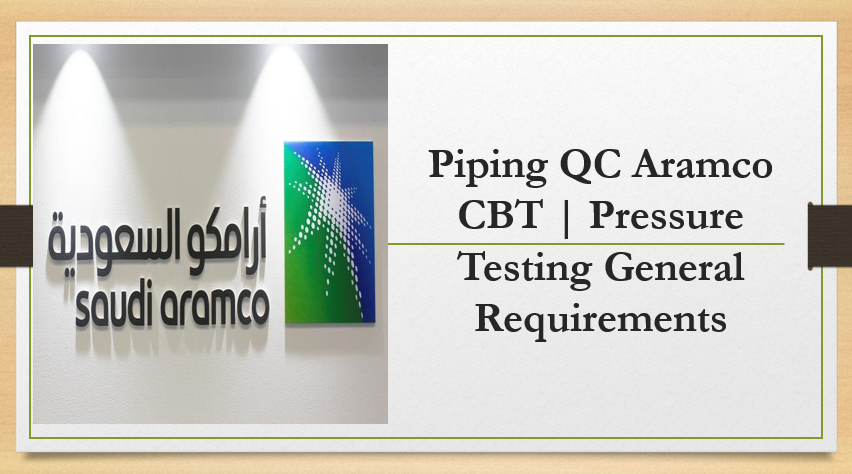This article is about Piping QC Aramco CBT related to topic of Pressure Testing General Requirements Activity as per SAES-A-004.

Piping QC Aramco CBT | Pressure Testing General Requirements
PRESSURE TESTING REFERENCE STANDARD
- SATIP-A-004-02 Hydrostatic Testing of On-Plot Piping.
- SAES-A-004 General Requirements for Pressure Testing.
- SAES-A-007 Hydrostatic Testing Fluid & Lay-up Procedure.
- SAES-L-125 Safety Instruction Sheet for Piping & Pipeline.
- SAES-L-150 Pressure Testing of Plant Piping & Pipelines.
- G.I 0002.102 General Instruction Pressure Testing Safety.
HYDROSTATIC TEST
– A pressure test conducted using water or other approved liquid as the test medium.
PRE START-UP TEST
– A pressure test to ensure tightness of flanged and threaded joints at the test Pressure. It is normally conducted before initial start-up, during commissioning or after T&Is.
PNEUMATIC TEST
– A pressure test conducted using air or other approved gas as the test medium or in conjunction with liquid.
PRESSURE TEST
– A test conducted to piping or equipment by subjecting it to an internal pressure using liquid or gas to ensure strength or tightness of the system at the test pressure.
REVALIDATION TEST
– A pressure test performed to prove the integrity of existing piping or equipment. This test is administered by the proponent organization.
SERVICE TEST
– A pressure test conducted at operating pressure using the service fluid.
STRENGTH TEST
– A pressure test at an internal pressure determined in accordance with this standard and the applicable Code to verify the integrity of the piping systems or equipment for service at the design pressure.
SYSTEM TEST
– An in-situ pressure test applied to a group of piping and equipment tested as a system.
PRESSURE TEST PROCEDURE
– Information assembled to ensure all requirements listed in GI-0002.102, All referenced Saudi Aramco standards and Industrial standards are met.
TIGHTNESS TEST
– A pressure test to ensure tightness of the piping system (i.e., no leaks in the system) at the test pressure.
SAES-A-004 General Requirements for Pressure Testing
ALL SYSTEM (PIPING & EQUIPMENT) WHILE PRESSURE TESTING SHALL BE PROTECTED FROM BEING OVER PRESSURED BY THE FOLLOWING
- RELIEF VALVE (s) of adequate capacity set to relieve at 5% above the test pressure shall be installed unless the test pressure is less than 85% SMYS at which time it can be set at 10%
above the test pressure. Sizing of these relief valves used for testing shall follow the requirements of API RP 520, Part 1. The relief valve(s) shall be tested, dated, and tagged within One Week prior to the pressure test for new construction projects, and within One Month for maintenance operations. - In addition to the pressure relieving device, a bleed valve shall be provided to protect the piping and equipment from over pressure. The bleed valve shall be readily accessible in case immediate depressurization is required.
- An isolation valve shall be provided between the pressure testing manifold and the system being tested. The isolation valve shall be rated for the manifold test pressure when in the
closed position. - PRESSURE GAUGES and pressure recorders shall be calibrated before the Test. The calibration interval shall not exceed one (1) month. Calibration certificates shall be made available to Inspection personnel prior to commencement of the pressure test. Stickers shall be applied indicating the latest calibration date.
- All gauges shall have a range such that the test pressure is within 30 to 80% of the full range.
- A minimum of two pressure gauges are required for the test system. One pressure gauge shall be on the test manifold and the other(s) on the test system. Their accuracy shall be within 5% of one another.
- When large systems are tested, Inspection personnel will determine the need for additional gauges.
- Recording gauges shall be used where it is necessary to keep a permanent record, e.g., when the test duration exceeds four hours, or otherwise as required by this standard.
- PRESSURE TESTING MANIFOLD in the actual system pressure test, it shall be separately pressure tested to at least 1.2 times the system test pressure but not less than the discharge pressure of the pump used for the pressure testing.
HYDRO-TEST Package Content Test procedure shall be available at site all times.
- Flow chart.
- Hydro test index.
- SIS / Test press diagram / legend.
- Piping plan drawing.
- P&ID drawing.
- Isometric drawing.
- Welding summary report including NDT report & RTFI assessment.
- Support type & drawing.
- Valve test certificate.
- Flange joint inspection report.
- Internal cleaning & flushing report.
- Pre-test punch list – punch “A” should be close prior for proceeding test package review & testing.
- Reinforcing pad pneumatic test report.
- Calibration report.
- Filling & pressurization report.
- Pressure test report.
- Lay-up report.
- Reinstatement.
- Final inspection report.
- Coating report.
PIPING QC CBT QUESTIONS | FLANGE JOINT TIGHTENING METHODS
Piping QC Notes CBT Aramco | PIPE FIT-UP AND TOLERANCES
Piping QC Notes & CBT Aramco | Piping Erection & Installation
For more knowledge please check Ebooksterminal.com